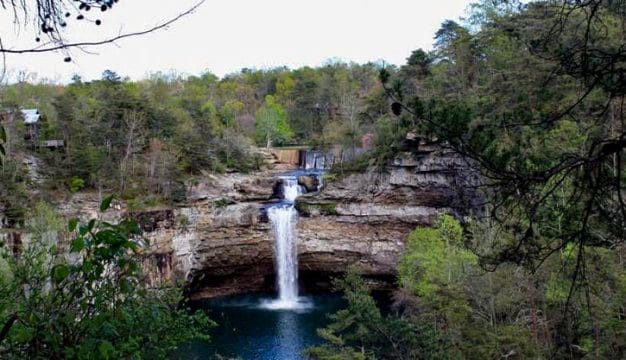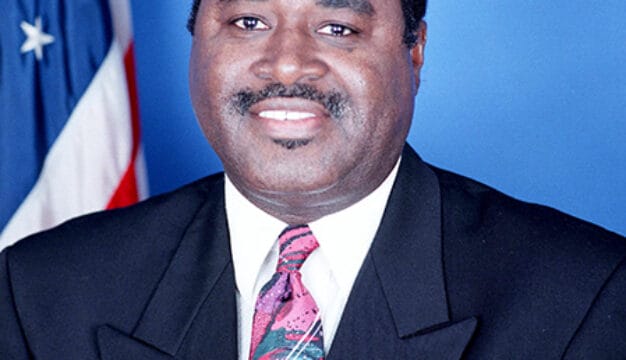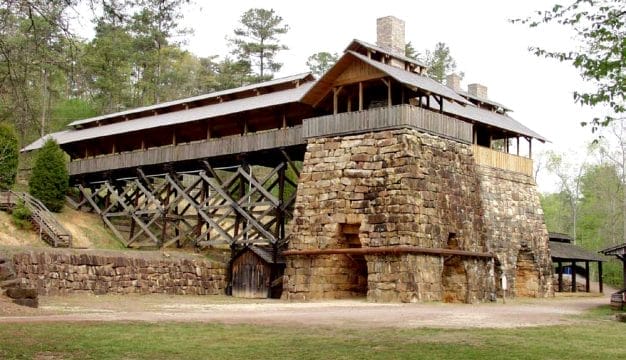Lincoln School
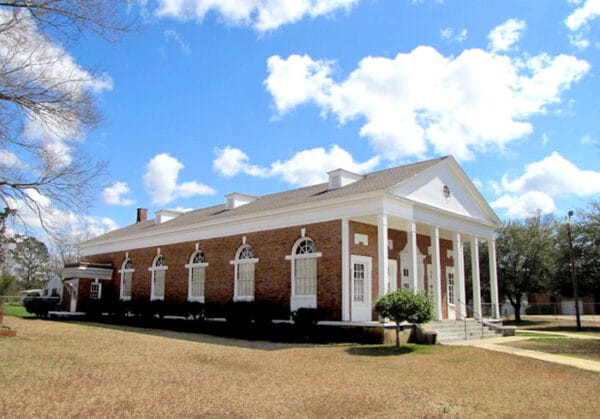 Phillips Memorial Auditorium
The Lincoln School in Marion, Perry County, was one of the first institutions established for the education of African Americans after the Civil War. Counting among its graduates Coretta Scott King, the school was open for more than 100 years, and was the foundation for Alabama State University, closing only after Perry County schools were integrated in the late 1960s.
Phillips Memorial Auditorium
The Lincoln School in Marion, Perry County, was one of the first institutions established for the education of African Americans after the Civil War. Counting among its graduates Coretta Scott King, the school was open for more than 100 years, and was the foundation for Alabama State University, closing only after Perry County schools were integrated in the late 1960s.
The origins of the school lay in the efforts of the American Missionary Association (AMA) and the Freedman’s Bureau to educate blacks following emancipation. In 1867, representatives of the AMA selected Marion as the site and worked with local residents, including nine formerly enslaved men, to raise the necessary funds. One of the men, Alexander Curtis, took the lead in establishing the institution as a normal school, which would provide teacher training in addition to a regular curriculum, but this goal would not be realized for a number of years. The school followed the model of a typical educational institution of the time, filing a charter and incorporating, on July 18, 1867. There is a widely circulating legend that the school’s origins lie with a Union soldier who taught local black children as he was recovering from wounds sustained in the Civil War, but there is no hard evidence to support this claim.
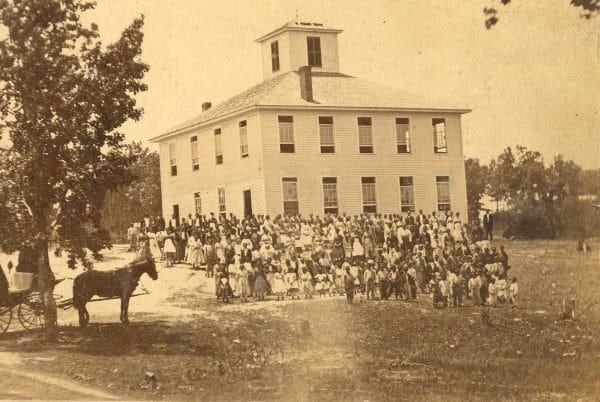 Lincoln Normal School
The AMA leased a building in 1868 to house the school, provided teachers, and established the original curriculum, which consisted of the typical subjects found in a classical education, including Greek, mathematics, history, and chemistry. George N. Card, a white educator, was installed as the first president. The following year, the AMA, in coordination with the Freedman’s Bureau and free Blacks in the area, began raising funds for a new facility. The group raised $4,200, and in 1870, the Alabama Legislature added an appropriation of $486. By the following year, the state was contributing $1,250. In 1871, the state approved a bill to establish four teacher-training schools, and Marion was selected as the site for one of them. In December 1873, the AMA deeded the school to the state with the proviso that it be used as a normal college for African Americans.
Lincoln Normal School
The AMA leased a building in 1868 to house the school, provided teachers, and established the original curriculum, which consisted of the typical subjects found in a classical education, including Greek, mathematics, history, and chemistry. George N. Card, a white educator, was installed as the first president. The following year, the AMA, in coordination with the Freedman’s Bureau and free Blacks in the area, began raising funds for a new facility. The group raised $4,200, and in 1870, the Alabama Legislature added an appropriation of $486. By the following year, the state was contributing $1,250. In 1871, the state approved a bill to establish four teacher-training schools, and Marion was selected as the site for one of them. In December 1873, the AMA deeded the school to the state with the proviso that it be used as a normal college for African Americans.
Under Card’s guidance, the school reorganized in 1874 as the State Normal School for Colored Students in Marion and expanded to include a teacher-training program while still carrying on its primary education mission. In late 1886, a group of local whites petitioned to have the school removed after an altercation between white students from Howard College and Black Lincoln students. In the petition, the group complained that the school was dissuading prospective white students from coming to Marion. Some Black residents responded by boycotting white businesses. The petition was received favorably by the legislature, which agreed in 1887 to fund an African American college or university somewhere other than Marion. Booker T. Washington, who had just opened Tuskegee Normal Industrial School in 1881, opposed locating it in Montgomery as too close to Tuskegee, Macon County, preferring that it be located in Birmingham. Other options included Brewton, Mobile, and Selma. Notably in Birmingham and Selma, white residents voiced opposition to locating a Black normal school in those cities and were heeded.
Ultimately, the school’s trustees chose Montgomery, and the last Marion class graduated in June 1888. The Marion school was split, and the teacher-training component moved to Montgomery and became the Alabama Colored People’s University. This school would evolve into present-day Alabama State University. The legislature forbid another normal school on the land vacated in Marion but did allow for a regular public school. Meanwhile, Howard, which was experiencing falling enrollments, was moved in 1887 to Birmingham to take advantage of that city’s economic growth. It would become Samford University. Howard president Col. James T. Murfee stayed in Marion with a small group of faculty who together formed a new college for young men, Marion Military Institute.
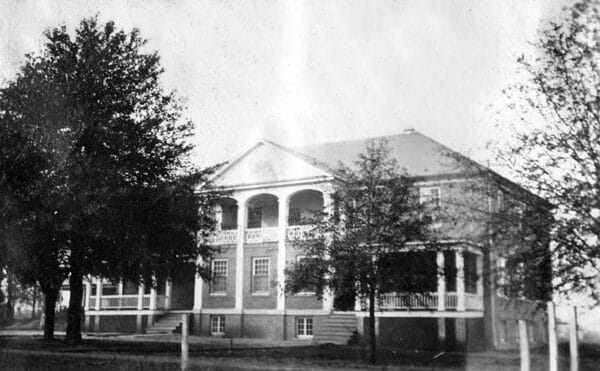 Woolworth Hall
Also in 1887, the school building in Marion burned from unknown causes, but rumors swirled about possible arson by whites in the town opposed to black education. Facing financial hardships resulting from the fire and the loss of the normal school, school supporters again turned to the AMA for help, and the organization responded by purchasing the home of the former principal of the Normal School, William Burns Paterson, for use by the school’s teachers. (Of note, Paterson is the great-grandfather of Alabama author Judith Hillman Paterson.) For the next nine years, the school’s survival was tenuous. In 1896, Talladega College teacher Mary Elizabeth Phillips was named principal of the school. Within a year, the AMA moved to close the school because of its financial difficulties, but Phillips rallied the school and the surrounding townspeople to raise pledges totaling $1,300 as well as an additional $100 pledge from the students; the teachers agreed to forego their salaries for a year as long as the town would supply them food. Phillips’s dedication to the school was further demonstrated in 1902 when she learned how to lay bricks and taught her students to do so to finish a school building when funds ran short to pay brick masons.
Woolworth Hall
Also in 1887, the school building in Marion burned from unknown causes, but rumors swirled about possible arson by whites in the town opposed to black education. Facing financial hardships resulting from the fire and the loss of the normal school, school supporters again turned to the AMA for help, and the organization responded by purchasing the home of the former principal of the Normal School, William Burns Paterson, for use by the school’s teachers. (Of note, Paterson is the great-grandfather of Alabama author Judith Hillman Paterson.) For the next nine years, the school’s survival was tenuous. In 1896, Talladega College teacher Mary Elizabeth Phillips was named principal of the school. Within a year, the AMA moved to close the school because of its financial difficulties, but Phillips rallied the school and the surrounding townspeople to raise pledges totaling $1,300 as well as an additional $100 pledge from the students; the teachers agreed to forego their salaries for a year as long as the town would supply them food. Phillips’s dedication to the school was further demonstrated in 1902 when she learned how to lay bricks and taught her students to do so to finish a school building when funds ran short to pay brick masons.
By the time that Phillips died in 1927, the school had expanded to nearly 600 students, 26 teachers, 11 buildings serving various functions, and 40 acres of land that included a farm. Two dormitories housed students who did not live within easy daily travel distance from the school. In 1939, the school dedicated its newly finished auditorium to Phillips.
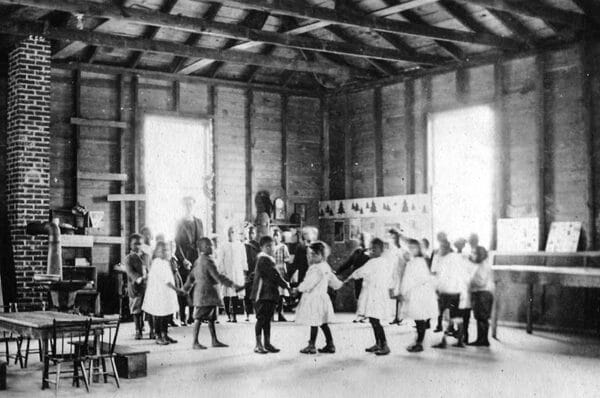 Lincoln Normal School Kindergarten
During the Great Depression, Lincoln School suffered financial hardships along with the rest of the nation. To save money, the dormitories were closed and tuition was reduced from $25 to $9 to encourage enrollment. By 1938, the AMA had persuaded Perry County to provide a small amount of the school’s teacher salaries, enabling all students to go to the school tuition-free. The school survived the decade, and in 1943 the school appointed its first African American principal, Ernest Smith, who was pastor of the local black Methodist church. White teachers had taught alongside African American teachers for years at the school, but when Perry County began providing money to the school in 1943, these teachers were let go, and Lincoln became an all-black institution. The AMA continued subsidizing the principal’s salary as late as 1954 and allowed Perry County use of the school facilities for free but did not deed the property to the county.
Lincoln Normal School Kindergarten
During the Great Depression, Lincoln School suffered financial hardships along with the rest of the nation. To save money, the dormitories were closed and tuition was reduced from $25 to $9 to encourage enrollment. By 1938, the AMA had persuaded Perry County to provide a small amount of the school’s teacher salaries, enabling all students to go to the school tuition-free. The school survived the decade, and in 1943 the school appointed its first African American principal, Ernest Smith, who was pastor of the local black Methodist church. White teachers had taught alongside African American teachers for years at the school, but when Perry County began providing money to the school in 1943, these teachers were let go, and Lincoln became an all-black institution. The AMA continued subsidizing the principal’s salary as late as 1954 and allowed Perry County use of the school facilities for free but did not deed the property to the county.
In 1954, the U.S. Supreme Court declared segregation in public schools unconstitutional in the Brown v. Board of Education case, resulting in the eventual closing of Lincoln and other segregated schools. In 1960, the AMA severed its remaining ties with the school, and the state took over full operation. Lincoln celebrated its 100th anniversary in 1967 and graduated its final high school class in 1969 and its final sixth-grade class in 1970, when it ceased operations. The school’s alumni association remains active and celebrates the school’s importance to African Americans in Marion for more than 100 years. The association has preserved one of the school’s original buildings and now owns the 22 acres of the original school campus. On July 19, 2019, 100 ASU freshmen made a pilgrimage to the Lincoln Normal School campus and participated in a ceremony to celebrate the school’s heritage.
Additional Resources
Caver, Joseph. From Marion to Montgomery: The Early Years of Alabama State University, 1867-1925. Montgomery, Ala.: New South Books, 2020.
Richardson, Joe M., and Maxine D. Jones. Education for Liberation: The American Missionary Association and African Americans, 1890 to the Civil Rights Movement. Tuscaloosa: University of Alabama Press, 2009.
Sherer, Robert G. Black Education in Alabama, 1865-1901. Tuscaloosa, Ala.: University of Alabama Press, 1997.

